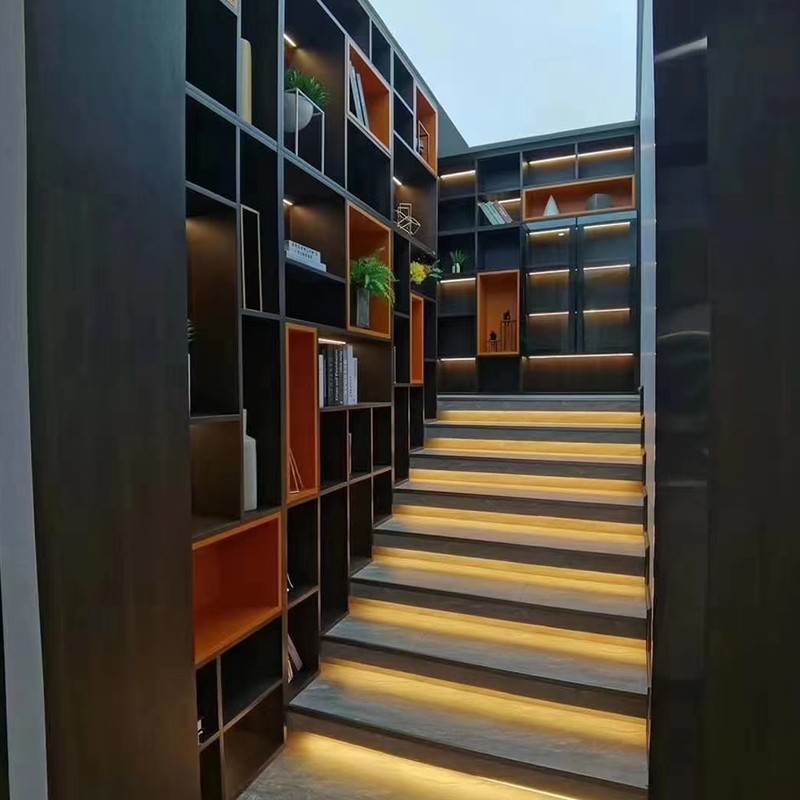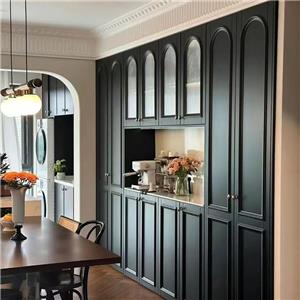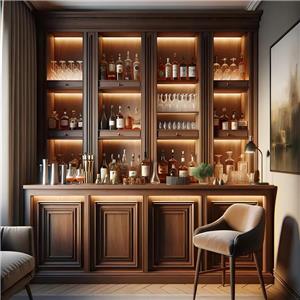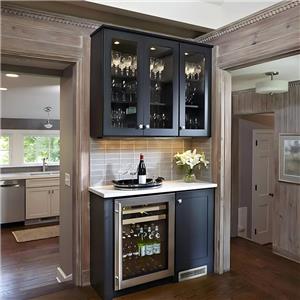How much weight can a bookcase wall bear?
A bookcase wall is a functional and aesthetic home design that can not only store books, but also display decorations and can even be used as a partition to separate spaces. In home decoration, bookcase walls are often one of the focuses of attention, especially for those who have a strong interest in reading and collecting books.
However, when designing and installing bookcase walls, a key issue is often overlooked - how much weight can a bookcase wall bear? This is a question of safety and practicality. If the load-bearing capacity of the bookcase wall is not properly assessed, it may not only cause the bookcase to deform and damage, but may even pose a threat to family safety. Therefore, it is crucial to understand the load-bearing capacity of the bookcase wall. This article will explore this in detail.

What are the factors affecting the load-bearing capacity of the bookcase wall?
The load-bearing capacity of the bookcase wall is affected by many factors, including materials, design, installation methods, and the structure of the wall itself. These factors together determine the upper limit of the weight that the bookcase wall can safely bear.
The influence of material selection
The material of the bookcase wall directly affects its load-bearing capacity. Common bookcase materials include solid wood, composite panels, metal, and glass. The physical properties of different materials, such as density, strength, and elastic modulus, will affect the load-bearing capacity of the bookcase. For example, solid wood bookcases usually have a higher load-bearing capacity because solid wood has a higher density and strength; while composite panels tend to have a lower load-bearing capacity than solid wood because their internal structure may be loose.
Impact of design and structure
The design and structure of the bookcase have a crucial impact on its load-bearing capacity. The height, width, depth, thickness of the partitions, and the support method of the bookcase will affect its overall load-bearing capacity. For example, a taller bookcase may have a lower load-bearing capacity due to its higher center of gravity and poor stability. Bookcases with thinner partitions are prone to bending and deformation when carrying heavy objects, which affects their service life and safety.
Impact of installation method
The installation method of the bookcase wall is also one of the key factors that determine its load-bearing capacity. If the bookcase is not installed correctly, it may cause structural instability, which in turn affects its load-bearing capacity. Common installation methods include hanging, embedded, and freestanding. The hanging bookcase wall needs to pay special attention to the load-bearing capacity of the wall at the installation location. If the wall load-bearing capacity is insufficient, the bookcase is easy to fall off. Embedded bookcases usually rely on the support of the wall, so their load-bearing capacity is strong. The load-bearing capacity of a free-standing bookcase depends on the stability and design of its own structure.
Influence of wall structure
The bookcase wall is usually fixed to the wall, so the structure and material of the wall have a direct impact on the load-bearing capacity of the bookcase. Different types of walls (such as gypsum board walls, brick walls, concrete walls, etc.) have different load-bearing capacities. For example, brick walls and concrete walls usually have a higher load-bearing capacity and can withstand a large weight; while gypsum board walls are relatively fragile and have poor load-bearing capacity, and are easily damaged by excessive loads.
What is the load-bearing capacity of bookcase walls of different materials?
In order to better understand the load-bearing capacity of bookcase walls, we can start with bookcases of different materials and analyze their load-bearing performance and applicable scenarios.
Solid wood bookcase wall
Solid wood bookcases are usually the type of bookcases with the strongest load-bearing capacity. Solid wood has a high density and strength, and can hold a large number of books and decorations. Solid wood bookcases made of oak, cherry or walnut are particularly strong and durable, and can usually bear 50-100 pounds (about 22-45 kilograms) per partition, depending on the thickness and length of the partition. However, the disadvantage of solid wood bookcases is that they are more expensive and may be warped or cracked due to the natural characteristics of wood due to humidity and temperature.
Composite board bookcase wall
Composite boards (such as medium-density fiberboard, particleboard, etc.) are common bookcase materials in modern homes. Compared with solid wood, composite boards are less expensive and less susceptible to humidity. However, composite boards usually have a lower load-bearing capacity than solid wood, especially when carrying a large number of books, and the partitions are prone to bending. Generally speaking, each partition of a composite board bookcase has a load-bearing capacity of about 30-50 pounds (about 13-22 kilograms), depending on the density and quality of the board.
Metal bookcase wall
Metal bookcases are often used in industrial or modern style home designs. Metal is very strong and durable, so it has a high load-bearing capacity. Steel bookcases are the most common type of metal bookcases, and their partitions usually have a load-bearing capacity of more than 100 pounds (about 45 kilograms), or even higher. In addition, metal bookcases are usually compact in structure and can bear a large weight without being easily deformed. However, the disadvantage of metal bookcases is that they are heavy and difficult to carry and install.
Glass bookcase walls
Glass bookcase walls are usually used to display books or decorations rather than to store a large number of books. Although glass bookcases look beautiful, they have a relatively low load-bearing capacity. Tempered glass is the most commonly used material in glass bookcases. It has high strength, but its load-bearing capacity is usually no more than 30 pounds (about 13 kilograms) and needs to be used with caution to prevent the glass from breaking.

How to calculate the load-bearing capacity of a bookcase wall?
When choosing or designing a bookcase wall, it is important to know how to calculate its load-bearing capacity. Here are some simple steps and methods to help you evaluate the load-bearing capacity of a bookcase wall.
Evaluate materials and design
First, evaluate the basic load-bearing capacity of the bookcase wall based on its materials and design. Understand the strength and density of different materials, as well as the thickness and size of each part of the design (such as partitions, back panels, brackets, etc.). This information can usually be obtained from the manufacturer or designer.
Calculate the load-bearing capacity of the partition
The partition of the bookcase wall is the main part that carries books and decorations, so its load-bearing capacity directly affects the load-bearing capacity of the entire bookcase wall. A simple way is to use the area of the partition (length × width) multiplied by the material's load-bearing factor (usually in pounds per square foot or kilograms per square meter). For example, if a solid wood partition is 3 feet long and 1 foot wide, and the material's load-bearing factor is 50 pounds per square foot, then the partition has a load-bearing capacity of about 150 pounds (about 68 kilograms).
Consider the wall structure and fixing method
The structure of the wall and the fixing method of the bookcase are also important factors affecting the load-bearing capacity. Make sure the bookcase wall is installed on a load-bearing wall or fixed by a reliable bracket to maximize its load-bearing capacity. If the bookcase is installed on a gypsum board wall, it is recommended to use professional fixings such as expansion bolts or steel brackets to enhance the wall's load-bearing capacity.
Test and adjust
Before actual use, it is recommended to test the bookcase wall for load bearing. You can gradually increase the weight of books or other items to observe the stability of the bookcase and the bending of the partitions. If the bookcase is found to be deformed or unstable, you should immediately reduce the weight and make adjustments, such as adding brackets or replacing stronger materials.

How to increase the load-bearing capacity of the bookcase wall?
If the existing bookcase wall does not meet your storage needs, or you plan to store a large number of books and items, you can take the following measures to increase the load-bearing capacity of the bookcase wall.
Add support structure
A simple and effective way is to increase the support structure of the bookcase wall. For example, you can add support bars or brackets under the bookcase partitions to reduce the bending of the partitions. Alternatively, use thicker partitions or add vertical support columns in the middle of the partitions to increase their load-bearing capacity.
Upgrade materials
If the material load-bearing capacity of the existing bookcase is limited, you can consider replacing or upgrading the material. For example, replacing composite panels with solid wood or metal can significantly increase the load-bearing capacity of the bookcase. In addition, using higher density composite panels or reinforced glass can also enhance the load-bearing performance of bookcases.
Proper weight distribution
When using bookcase walls, proper weight distribution is also the key to improving load-bearing capacity. For example, place heavier books and items at the bottom of the bookcase or near the support columns to reduce the load on the partitions and walls. Lighter items can be placed at the top of the bookcase or near the edge.




